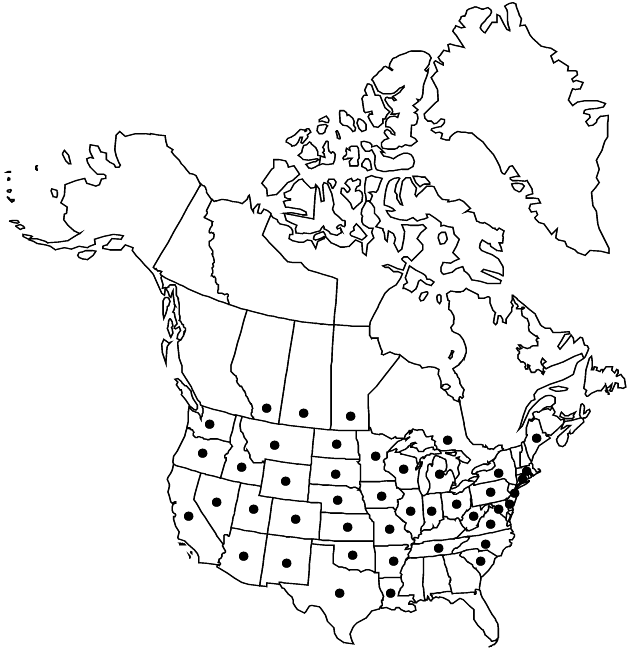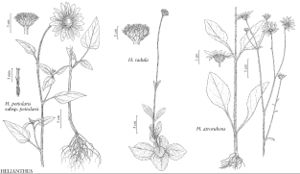familyAsteraceae
genusHelianthus
speciesHelianthus petiolaris
subspeciesHelianthus petiolaris subsp. petiolaris
Difference between revisions of "Helianthus petiolaris subsp. petiolaris"
Synonyms: Helianthus couplandii B. Boivin
FNA>Volume Importer |
FNA>Volume Importer |
||
| Line 22: | Line 22: | ||
|elevation=10–1500(–2000) m | |elevation=10–1500(–2000) m | ||
|distribution=Alta.;Man.;Ont.;Sask.;Ariz.;Ark.;Calif.;Colo.;Conn.;Del.;D.C.;Idaho;Ill.;Ind.;Iowa;Kans.;La.;Maine;Mass.;Mich.;Minn.;Mo.;Mont.;Nebr.;Nev.;N.J.;N.Mex.;N.Y.;N.C.;N.Dak.;Ohio;Okla.;Oreg.;Pa.;S.C.;S.Dak.;Tenn.;Tex.;Utah;Va.;Wash.;W.Va.;Wis.;Wyo. | |distribution=Alta.;Man.;Ont.;Sask.;Ariz.;Ark.;Calif.;Colo.;Conn.;Del.;D.C.;Idaho;Ill.;Ind.;Iowa;Kans.;La.;Maine;Mass.;Mich.;Minn.;Mo.;Mont.;Nebr.;Nev.;N.J.;N.Mex.;N.Y.;N.C.;N.Dak.;Ohio;Okla.;Oreg.;Pa.;S.C.;S.Dak.;Tenn.;Tex.;Utah;Va.;Wash.;W.Va.;Wis.;Wyo. | ||
| − | |discussion=<p>Subsp. petiolaris is native to western North America and adventive elsewhere (e.g., introduced in Ontario). Hybrids with with H. annuus and H. debilis have been reported.</p> | + | |discussion=<p>Subsp. petiolaris is native to western North America and adventive elsewhere (e.g., introduced in Ontario). Hybrids with with <i>H. annuus</i> and <i>H. debilis</i> have been reported.</p> |
|tables= | |tables= | ||
|references= | |references= | ||
| Line 46: | Line 46: | ||
|publication year= | |publication year= | ||
|special status= | |special status= | ||
| − | |source xml=https://jpend@bitbucket.org/aafc-mbb/fna-data-curation.git/src/ | + | |source xml=https://jpend@bitbucket.org/aafc-mbb/fna-data-curation.git/src/8f726806613d60c220dc4493de13607dd3150896/coarse_grained_fna_xml/V19-20-21/V21_360.xml |
|tribe=Asteraceae tribe Heliantheae | |tribe=Asteraceae tribe Heliantheae | ||
|subtribe=Asteraceae (tribe Heliantheae) subtribe Helianthinae | |subtribe=Asteraceae (tribe Heliantheae) subtribe Helianthinae | ||
Revision as of 15:34, 18 September 2019
Stems usually hispidulous to strigillose, rarely ± hirsute to glabrate. Leaves: abaxial faces sparsely, if at all, gland-dotted. Peduncles usually bractless. Phyllaries 3–5 mm wide. Disc corollas: throats abruptly narrowed distal to densely hairy basal bulbs. 2n = 34.
Phenology: Flowering early summer–fall.
Habitat: Dry open areas, usually sandy soils
Elevation: 10–1500(–2000) m
Distribution

Alta., Man., Ont., Sask., Ariz., Ark., Calif., Colo., Conn., Del., D.C., Idaho, Ill., Ind., Iowa, Kans., La., Maine, Mass., Mich., Minn., Mo., Mont., Nebr., Nev., N.J., N.Mex., N.Y., N.C., N.Dak., Ohio, Okla., Oreg., Pa., S.C., S.Dak., Tenn., Tex., Utah, Va., Wash., W.Va., Wis., Wyo.
Discussion
Subsp. petiolaris is native to western North America and adventive elsewhere (e.g., introduced in Ontario). Hybrids with with H. annuus and H. debilis have been reported.
Selected References
None.
Lower Taxa
None.
... more about "Helianthus petiolaris subsp. petiolaris"
Alta. +, Man. +, Ont. +, Sask. +, Ariz. +, Ark. +, Calif. +, Colo. +, Conn. +, Del. +, D.C. +, Idaho +, Ill. +, Ind. +, Iowa +, Kans. +, La. +, Maine +, Mass. +, Mich. +, Minn. +, Mo. +, Mont. +, Nebr. +, Nev. +, N.J. +, N.Mex. +, N.Y. +, N.C. +, N.Dak. +, Ohio +, Okla. +, Oreg. +, Pa. +, S.C. +, S.Dak. +, Tenn. +, Tex. +, Utah +, Va. +, Wash. +, W.Va. +, Wis. + and Wyo. +
Present +
J. Acad. Nat. Sci. Philadelphia +
1821 +
Helianthus petiolaris subsp. petiolaris +
Helianthus petiolaris +
subspecies +
